BIO P1
1/92
There's no tags or description
Looks like no tags are added yet.
Name | Mastery | Learn | Test | Matching | Spaced |
|---|
No study sessions yet.
93 Terms
Frederick Griffith
he discorvered the transforming principle. Which was a two forms of bacteria that causes pneumonia. 1 form called S because was made of sugar molecules and the 2nd R bc of its raugh form. He injected this bacteria to a mice.
He concluded that some materials has been transferred from the heat-killed S bacteria to the live R bacteria. it contained information that changed harmless R bacteria into disease-causing S bacteria.
Oswald Avery
Identifies DNA or protein as the transforming principle or the genetic material.
They began by combining living R bacteria with an extract made from S bacteria.
This procedure allowed them to directly observe the transformation of R bacteria into S bacteria in a petri dish.
They then performed a series of tests to find out if the transforming principle was DNA or protein.
Alfred Hershey and Martha Chase
While trying to determine whether DNA or protein is the genetic material they made use of the following facts:
DNA does not contain sulfur, whereas protein does
DNA contains phosphorus, but protein does not
they discovered that the genetic material in a bacteriophage was DNA
Based on these results, Hershey and Chase concluded that the phages' DNA was the component that entered the bacteria, providing conclusive evidence that DNA is the genetic material, rather than the protein coat.
Bacteriophage
A virus that infects bacteria, or "phage" for short, takes over a bacterium's genetic machinery and directs it to make more viruses.
nucleotides
small units that make up a strand of DNA
3 types of nucleotides
sugar called deoxyribose (DNA)
phosphate group
nitrogen-containing base
(RNA)
4 bases of DNA
Adenine(double ring),
Thymine(single ring),
Guanine(double ring),
Cytosine(single ring)
Waston and Crick
Developed the current model for the DNA double helix; determine the structure of DNA, they discoverd this by the x-ray image of Rosalinda. Finding out that if they paired double-ringed nucleotides with single-ringed nucleotides, the bases fit like a puzzle.
They also suggested that dna may be copied.
Rosalinda Franklin
produces x-ray photographs of DNA that indicated it was a helix. using the technique called x-ray crystallography
Erwin Chargaff
Discovered that DNA composition varies, but the amount of adenine is always the same as thymine and the amount of cytosine is always the same as guanine. Also proved that DNA is hereditary.
double helix
two strands of DNA wind around each other like a twisted ladder. The strands are complementary —they fit together and are the opposite of each
other.
DNA nucleotides of a single strand are always joined by?
a covelent bonds that connects the sugar of one nucleotide to the phosphate of the next nucleotide.
base paring rules
they describe how nucleotides form pairs in DNA.
T always pairs w. A
G always pairs with C
Replication
Copying process by which a cell duplicates its DNA
It assures that every cell has a complete set of identical genetic information
Who does th actual work of replication?
Enzymes and other proteins. Dna does nothing more than store information.
DNA polymerase
enzymes that form bonds btw nucleotides durin replication. Creating two complete molecules of DNA
Explain the stages of DNA replication
Stage 1: Initiation. Two complementary strands are separated, Special enzymes, including helicase, untwist and separate the two strands of DNA.
Stage 2: Elongation. each strand becomes a template along which a new complementary strand is built. DNA polymerase brings in the correct bases to complement the template strand, synthesizing a new strand base by base. A DNA polymerase is an enzyme that adds free nucleotides to the end of a chain of DNA, making a new double strand. This growing strand continues to built until it has fully complemented the template strand.
Stage 3: Termination. Once the two original strands are bound to their own, finished, complementary strands, DNA replication is stopped and the two new identical DNA molecules are complete.
Why is DNA replication called “semiconservative”
because it conserves one old strand and makes one complementary new strand.
because one original strand of the double-stranded helix is found in each daughter cell
Central dogma
Define by Crick
which states that information flows in one direction, from DNA to RNA to proteins.
3 processes of central dogma
Replication, copies DNA (blue arrow).
Transcription converts a DNA message into an intermediate molecule, called RNA (red arrow).
Translation interprets an RNA message into a string of amino acids, called a polypeptide. Either a single polypeptide or many polypeptides working together make up a protein (green arrow).
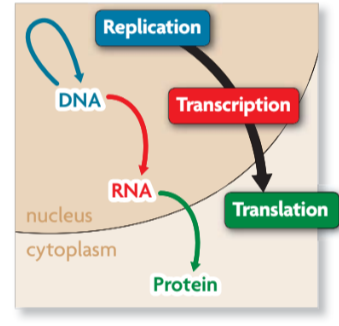
what processes occur in the nucleos during the central dogma
replication and transcription
RNA
or ribonucleic acid, is a chain of nucleotides, each made of a sugar, a phosphate group, and a nitrogen-containing base.
acts as an intermediate link between DNA in the nucleus and protein synthesis in the cytoplasm.
contains coded info for making proteins
RNA differs from DNA….
RNA as a ribose sugar
RNA has uracil instead of thymine
RNA is a single-stranded structure and DNA is a souble strand
DNA stays in nucleus, and RNA leaves nucleus
transcription
is the process of copying a sequence of DNA to produce a complementary strand of RNA.
RNA polymerases
enzymes that bond nucleotides together in a chain to make a new RNA molecule.
3 types of RNA are made form DNA
mRNA (messenger) made from DNA in nucleus, travels out of nucleus & finds a ribosome
tRNA (transfer) brings amino acids to the ribosomes; found in cytoplasm
rRNA (ribosomal) part of the ribosome; this is where proteins are made
Messenger RNA (mRNA)
carries copies of instructions for assembling amino acids into proteins.
what are ribosomes made up
of proteins and rRNA
CONCEPT MAP ABOUT RNA
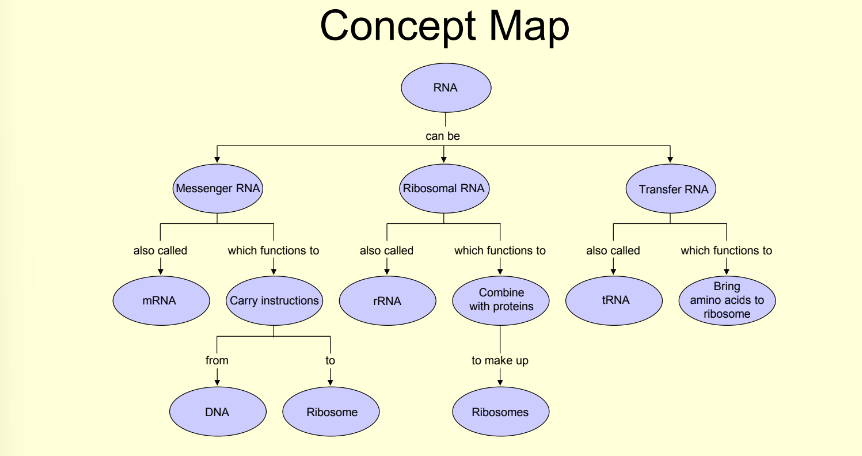
transcription steps
RNA polymerase binds to the promoter
site finds the starting point of a gene on the DNA
RNA polymerase adds RNA nucleotides
complimentary to the DNA strand, except it uses uracil instead of thymine
mRNA building is complete when the
RNA polymerase reaches a Termination
(stop) site on the DNA
This strand of mRNA is EDITED before
leaving the nucleus & carrying the code
into the cytoplasm
differences and similarities on transcription and replication
SIMILARITIES
Both processes occur within the nucleus of eukaryotic cells.
Both are catalyzed by large, complex enzymes.
Both involve unwinding of the DNA double helix.
both involve complementary base pairing to the DNA strand.
DIFFERENCES
Replication ensures that each new cell will have one complete set of genetic instructions. It does this by making identical sets of double-stranded chromosomes. This makes DNA especially well suited for long-term storage because it helps protect DNA from being broken down.
molecules. Replication occurs only once during each round of the cell cycle.
Transcription enables a cell to adjust to changing demands. It does so by making a single-stranded complement of only a segment of DNA and only when that particular segment is needed.
translation
is the process that converts, or translates, an mRNA message into a polypeptide.
codons
is a sequence of three nucleotides that codes for an amino acid.
The genetic code matches…
.each codon to its amino acid or function.
by what are amino acids coded by?
mRNA base sequences, they code for the same amino acids
stop codons
they are three
signal the end of the amino acid chain.
start codon
there is only one, which signals the start of translation and the amino acid methionine.
with what does translation always starts
methionine
why are amino acids linked?
to become protein
how does a cell actually translate a codon into an amino acid ?
by ribosomes and tRNA
ribosomes
are made of a combination of rRNA and proteins, and they catalyze the reaction that forms the bonds between amino acids.
anticodon
is a set of three nucleotides that is complementary to an mRNA codon.
carried by the tRNA
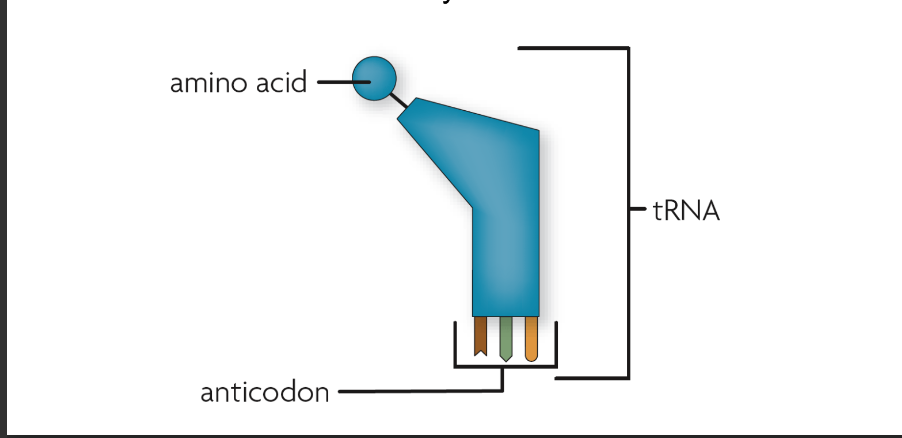
2 subunits of ribosome
The large subunit has three binding sites for tRNA.
The small subunit binds to mRNA.
translation process
Translation converts an mRNA transcript into a polypeptide.
For translation to begin, tRNA binds to a start codon and
signals the ribosome to assemble. A complementary tRNA molecule binds to the exposed codon, bringing its amino acid close to the first amino acid.
The ribosome helps form a polypeptide bond between
the amino acids and breaks the bond between the first tRNA
and its amino acid. The ribosome pulls the mRNA strand the length of one codon.
The ribosome pulls the mRNA strand the length of one codon. The first tRNA is shifted into the exit site, where it leaves the ribosome and returns to the cytoplasm to recharge. The first site is again empty, exposing the next mRNA codon.
The ribosome continues to translate the mRNA strand
until it reaches a stop codon. Then it releases the new
protein and disassembles.
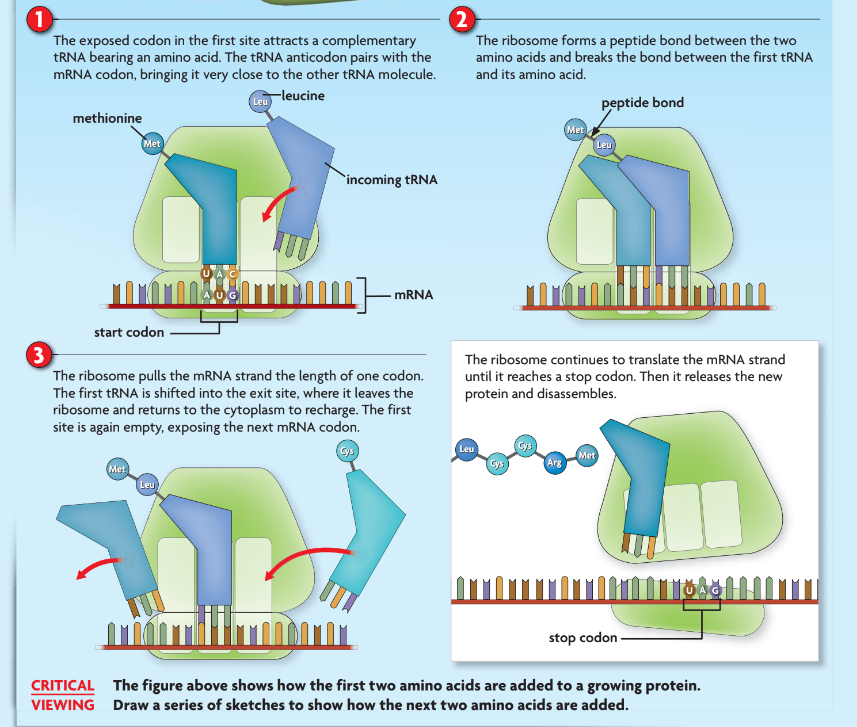
promoter
promoter is a DNA segment that allows a gene to be transcribed. It helps RNA polymerase find where a gene starts.
operator
is a DNA segment that turns a gene “on” or “off.” It interacts with proteins that increase the rate of transcription or block transcription from occurring.
operon
is a region of DNA that includes a promoter, an operator, and one or more structural genes that code for all the proteins needed to do a specific task.
exons
exons are nucleotide segments that code for parts of the protein.
introns
Introns are nucleotide segments that intervene, or occur, between exons.
how is mRNA edited
On a mRNA strand there are areas called: Exons and Introns
Introns are cut out before leaving the nucleus Exons are left, and this shortened piece of mRNA leaves the nucleus and gets Translated into Proteins
The introns are cut out of RNA molecules.
The exons are the spliced together to form mRNA.
mutations
is a change in the an organism’s DNA.
Types of point mutation
silent: the substitution does not change the amino acid
missense : the substitution changes the amino acids
nonsense: the substitution changes the amino acids to a stop
point mutation
a base is substituted for another
frameshift mutations
a base is deleted or inserted changing the reading frame therefore the amino acids sequence
mutagens
chemical or physical agents in the environment
pesticides
sequence radiation
x-rays
pollutants
types of mutations
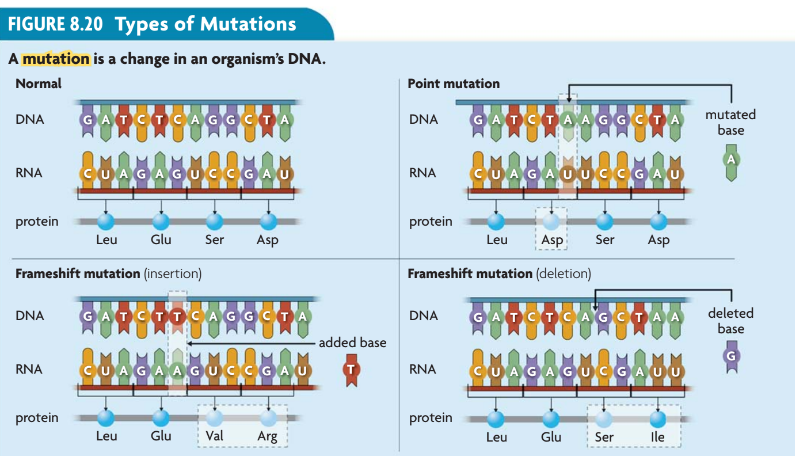
what does genetic variations leads to?
leads to phenotypic variations- which is necessary for natural selection. In other words natural selections acts on diff phenotypes in a population , in order to have diff phenotypes, a population must have genetic variations.
where does genetic variation stored
in a population’s gene pool
gene pool
the combined alleles of all of the individuals in a population.
how can diff combination of alleles in a gene pool can be formed?
when organism mate and have offspring
allele frequency
is a measure of how common a certain allele is in the population.
from what sources does genetic variation comes from
mutation
this change can from new alleles
passed on to offspring if in reproductive cell
recombination
forms new combinations of alleles
usually occurs during meiosis
parent’s alleles arranged in new ways in gametes
hybridization
the crossing of two different species that share common genes.
occurs when individuals can’t find mate of their own species
topic of current scientific research
natural distribution
which the frequency is highest near the mean value and decreases toward each extreme end of the range
traits no undergoing natural selection have a normal distribution
microevolution
is the observable change in the allele frequencies of a population over time. can result from natural selection
natural selection can change the distribution of a trait along one of three paths
directional selection: favors phenotypes at one extreme
stabilizing selection: favors the intermediate phenotype
disruptive selection: favors both extreme phenotype
gene flow
The movement of alleles from one population to another and reproduce
keeps neighboring populations similar
what does low gene flow do
it increases the chances that two populations will evolve into diff species
genetic drift
is a changes in allele frequencies that are due to chance
may cause loss of genetic diversity
common in small populations
bottleneck effect
describes the effect of a destructive event that leaves only a few survivors in a population. this may lead to a genetic drift, when an event reduces drastically its population.
founder effect
is genetic drift that occurs after a small number of individuals colonize a new area a new population. may lead to a genetic drift. The founder effect is a genetic drift that occurs after start of new population
negative effects on a population of a genetic drift
less likely to have some individual that can adapt
harmful alleles can become more common due to chance
sexual selection
occurs when certain traits increase mating success.
occurs due to higher cost of reproduction for females
males produce many sperm continuously
females are more limited in potential offspring each cycle
types of sexual selection
intrasexual selection: competition among males
intersexual selection: males display certain traits to females
heliocase
enzyme that unwinds DNA
okazaki fragments
fragments of copied DNA created on the lagging strand
leading strand
the strand that is copied in a continuous way, from the 3’ to 5’ direction
DNA Ligase
binds Okazaki fragments
DNA polymerase (structure)
Builds a new DNA strand by adding complementary bases
Single Strand Binding Proteins
stabilizes the DNA molecule during replication
lagging strand
strand that is copied discontinuously because it is traveling away from helicase
DNA primase
Initiates the synthesis DNA by creating a short RNA segment at replication fork
replication fork
two areas formed when the double helix separates during DNA replication
deoxyribose
sugar in DNA
why DNA srands are antiparallel
they are antiparallel because the two strands run in opposite directions.
the difference between the lagging and leading strand
leading, travels continuesly in a direction from 3’5.
lagging travels unconditionally and it goes the diff direction.
Topoisomerase
reduces ribosomal strain
RNA primer
is a RNA chain that is required by the DNA to begin its replication, is synthesized by the enzyme primase.
DNA polymerase I
removes RNA primer and replicates it with nucleotides (exonuclease)
DNA polymerase III
adds nucleotides in 5’— 3’ direction
chromatin
threads composed of DNA
What does Red blood cells do not contain
DNA
replacing the lagging strand utilizes…
DNA ligase
RNA primers
Okasaki fragments
what kind of chemical bond is found between the paired bases of the DNA double helix
hydrogen bonds